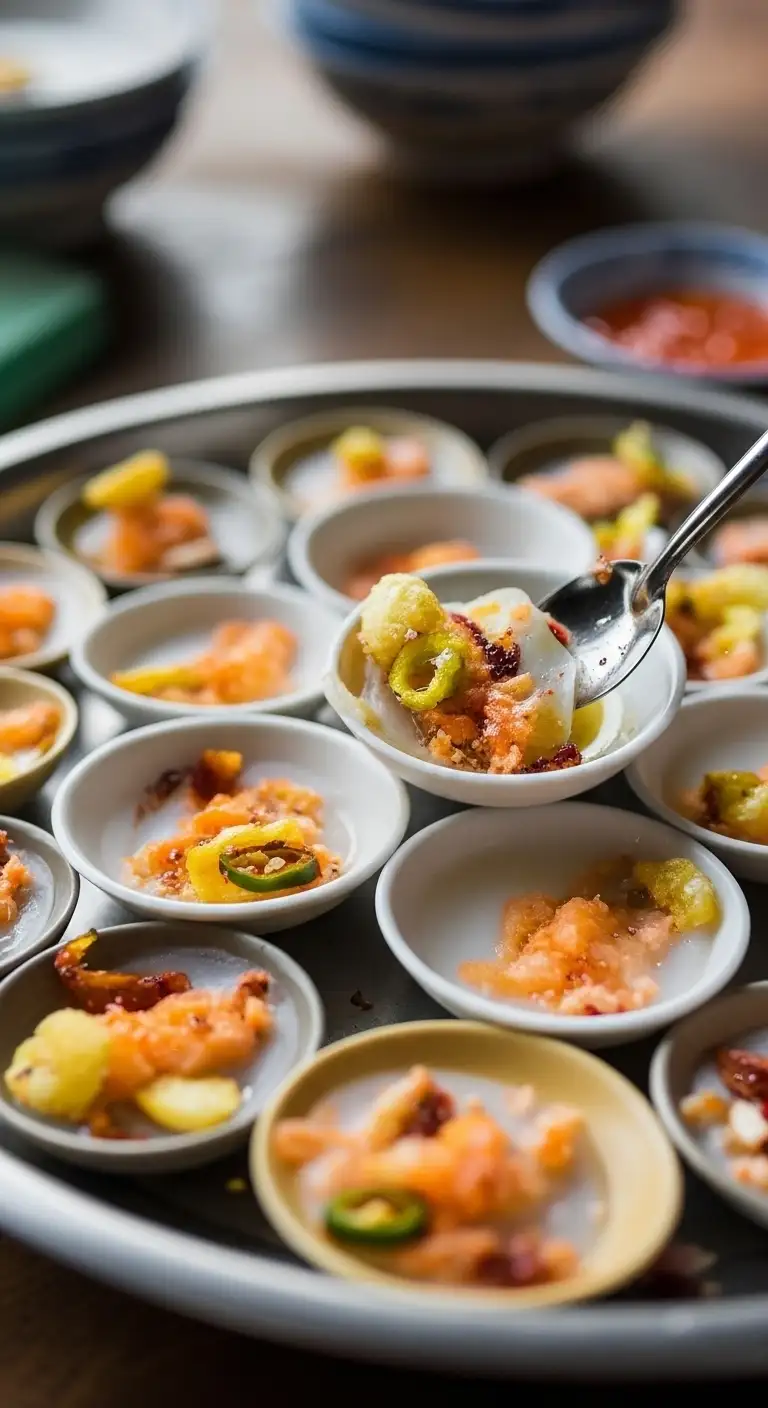Bánh Bèo (pronounced Ban Bey-Oh) is a quintessential Vietnamese delicacy, hailing from the former imperial capital of Huế in the Central region. These delicate, small steamed rice cakes are famous for their elegant, bite-sized form and harmonious blend of textures and flavors—a true representation of the refined art of Central Vietnamese royal cuisine.

Bánh Bèo: The Basics
The Name: The name Bánh Bèo translates roughly to “Water Fern Cake,” as the small, round, thin cakes resemble the floating leaves of the water fern plant.
The Texture: The cake itself is made primarily from rice flour and water, sometimes with a touch of tapioca starch. It is steamed until it forms a soft, smooth, and slightly chewy disc with a characteristic dimple in the center—perfect for holding the savory toppings.
The Toppings: Classic Bánh Bèo is topped with a vibrant combination of savory elements:
Tôm Cháy (Dried Shrimp Floss): Minced or powdered dried shrimp that has been pan-fried until fluffy, providing a savory, crunchy, and bright orange color.
Mỡ Hành (Scallion Oil): A drizzle of oil infused with fragrant green onions.
Da Heo Chiên Giòn (Crispy Fried Pork Skin/Cracklings): Pieces of crispy pork rinds (sometimes dried fried noodles) for a textural contrast.
Optional: Some variations also include a dollop of soft Mung Bean Paste (đậu xanh) for a creamy element.
A Snack or Appetizer: Bánh Bèo is typically enjoyed as a satisfying snack, appetizer, or part of a platter of assorted small Central Vietnamese bánh (cakes).
Types and Variations of Bánh Bèo
While the concept remains the same—a steamed rice cake with savory toppings and fish sauce—the method of serving and the ingredients can vary, particularly within its Central Vietnamese home:
A. Bánh Bèo Chén (The Classic Huế Style)
Description: This is the most famous and refined style. Each cake is steamed individually in a tiny, shallow ceramic saucer (chén).
Serving: A dozen or more small saucers are arranged neatly on a large tray, each cake topped with a perfect portion of tôm cháy and mỡ hành. The dipping sauce is poured directly into the chén over the cake before serving, or a small communal bowl of sauce is placed in the center.
B. Bánh Bèo Dĩa / Bánh Bèo Mâm (Platter Style)
Description: Instead of individual cups, the batter is steamed on a large, flat platter or plate. Once cooked, the cakes are often scraped off and served piled onto a large plate with the toppings and dipping sauce drizzled over.
Prevalence: This style is sometimes found in the South or in less formal Central street stalls.
C. Regional Filling Varieties (Central Vietnam)
Huế Style: Focuses on a thin, delicate cake texture and a filling primarily of dried shrimp and crispy pork skin. The presentation is meticulous, reflecting its royal heritage.
Quảng Nam/Đà Nẵng Style: Cakes tend to be larger and thicker with a slightly doughier consistency. The filling might be a more substantial mix of minced shrimp and meat (wet filling), sometimes topped with roasted peanuts, and often served with a spicier dipping sauce.
D. Sweet Bánh Bèo (Southern Adaptation)
Description: A distinctly Southern variation where the rice cake batter is sweetened, often colored green with pandan extract, and sometimes topped with mung bean paste.
Serving: This dessert version is typically served with a generous drizzle of rich coconut milk instead of savory fish sauce.

How to Eat Bánh Bèo Like a Local
Bánh Bèo is one of the few Vietnamese dishes that is not eaten with chopsticks.
The Spoon Technique (For Bánh Bèo Chén): The traditional method involves a small, flattened bamboo spoon or a small metal spoon.
Pour and Scoop: If the sauce hasn’t been pre-poured, drizzle a spoonful of the spicy-sweet fish sauce over the cakes in the saucers.
Scoop and Eat: Use the spoon to gently scrape the Bánh Bèo cake from the bottom of the saucer, ensuring you pick up all the savory toppings and the pooled dipping sauce. The entire cake is generally eaten in one bite.
No Dipping: Unlike Bánh Lọc, Bánh Bèo is typically eaten by pouring the sauce over the cakes and eating them directly from the saucers—the cakes are too thin and soft to be easily picked up and dipped individually.
Regional Differences: Central, North, and South
Bánh Bèo is a strong representation of Central Vietnamese cuisine, and its popularity and preparation decline as you move away from the central provinces.
| Region | Primary Characteristics | Key Flavor/Ingredient Differences |
|---|---|---|
| Central (Miền Trung) | The Origin and Heartland (especially Huế). The dish is refined, meticulously presented, and is the thinnest and most delicate form. | The savory dipping sauce is famously spicy and salty/umami-rich, reflecting the bold, intense flavors of Huế royal cuisine. Toppings include dried shrimp floss, scallion oil, and often crispy pork skin. Regional Central variations (like in Quảng Nam) feature a thicker cake. |
| South (Miền Nam) | Commonly Available, but with Adaptations. It is widely found in Southern cities like Ho Chi Minh City, often served alongside a mixed plate of other bánh (like Bánh Nậm, Bánh Lọc). | The savory version's dipping sauce is usually sweeter than the Central version, which is typical of Southern Vietnamese cooking. The South also features the unique Sweet Bánh Bèo made with pandan and coconut milk. |
| North (Miền Bắc) | Less Common/Rare. Bánh Bèo is not a traditional Northern dish. Northern cuisine focuses more on noodle soups (Phở) and delicate rice rolls (Bánh Cuốn). | When found, it is generally an imported version, often made to replicate the Southern style (and thus, may use a milder or slightly sweeter sauce). Northern food is generally mild and subtle, so the bold Central flavors are not natively characteristic of the North. |




